“. . . and ride to Neckar Vale”
The heart of the town lies in the Neckar Valley itself and thus the town leads the wanderer farther up the valley. The first stretch to Schlierbach and Ziegelhausen is enchanting. At Karlstor the hard granite of steep rock walls comes down close to the Neckar for a short distance — particularly on the right-hand side — and then to the left the valley opens up for a little while and is freer and more open. Looking back at Heidelberg from Haarlass or Stift Neuburg one sees a beautiful classical landscape of southern character.
Stift Neuburg, a charming idyll, lies somewhat higher to the left on its hill, framed in old trees. This unusually delightful spot has a strange and varied past. At the beginning of the 12th century a Benedictine Monastery was founded here. Then it became an aristocratic convent under electoral protection, a nunnery, a Jesuit and Lazarite monastery, from 1825 for about a century private property, first of the Frankfurt councillor Schlosser, a relation of Goethe, and until recently the property of an aristocratic family related to Schlosser, until finally in 1926 it was sold to the Benedictine Order. However, while it was private property there was a cultural and intellectual circle here frequented by guests from the world of literature, painting, music and politics. Marianne Willemer, Clemens Brentano, Friedrich von Schack, Karoline von Günderode, Carl Maria von Weber and many other well-known people of that time were guests here, until after the turn of the century another circle met here: the Neoromantics and exponents of symbolic poetry, who grouped themselves around Stephan George. It might well be said that it was Goethe’s spirit that was ever present here.
But now, continuing our wanders, we come back to our own times. Near the "Stiftsmühle", situated close to the Neckar, begin the first houses of the long-stretched village of Ziegelhausen, lying like a beautiful frame around the lower part of the Steinbach valley. At one time it had many commercial relations to the Palatine court in Heidelberg; now for the last hundred and fifty years or more it has been the seat of a flourishing laundry trade, still based on the work of numerous families. The composer Johannes Brahms lived in Ziegelhausen in 1875 and this was an important year for his musical development. During the last few decades both in Ziegelhausen as in Schlierbach, a suburb of Heidelberg, many new and modern private houses have been built on the sunny hills, causing the village-like character to drop into the background.
Whereas up to now there were many buildings on the banks, we now see from the lock-gate above Schlierbach the quiet valley landscape with its pure green belt. When we arrive at the Kümmelbacher Hof on the right, we have a view from the bend in the Neckar across the wide valley to Dilsberg, one of the finest pictures the Neckar offers. The right side of this picture is filled with the friendly little town of Neckargemünd, beginning with a large residential quarter and from the mouth of the Elsenz onwards showing the older heart of the town with pretty framework houses and many a charming corner. Kleingemünd, too, lying opposite, has been incorporated and has developed into a further residential colony.
Above the town, ion a hill, there are a few remains of the one-time important Reichenstein Castle, destroyed long ago. Passing along on the other side, too. or seen from above, Neckargemünd always presents a particularly fascinating view.
There is another remarkable thing near Neckargemünd. In ancient times the Neckar did not flow from near the present railway bridge straight through to the mouth of the Elsenz, but beforehand turned to the left and flowed through the now dry valley on the left side of the Hollmut ridge via Wiesenbach to shortly before Mauer, where it was again diverted from its new course by a projection of rock and on the other side of the Hollmut ridge — that is to say in the present Elsenz valley — came back to where Neckargemünd now lies. The geologists therefore regard the Hollmut ridge and the old Neckar loop as especially noteworthy and they often visit the sandpit at Grafenrain near Mauer where at the turn of the century the lower jaw of the Homo Heidelbergensis, whose age is estimated at 500.000 years, was Found in the sand of the Neckar. In later centuries the Neckar was somehow able, perhaps helped by a change due to landslides, to push through the straight stretch. Also in the upper course of the Neckar the valley contains some similar mountains around which the river once flowed.
Stift Neuburg, a charming idyll, lies somewhat higher to the left on its hill, framed in old trees. This unusually delightful spot has a strange and varied past. At the beginning of the 12th century a Benedictine Monastery was founded here. Then it became an aristocratic convent under electoral protection, a nunnery, a Jesuit and Lazarite monastery, from 1825 for about a century private property, first of the Frankfurt councillor Schlosser, a relation of Goethe, and until recently the property of an aristocratic family related to Schlosser, until finally in 1926 it was sold to the Benedictine Order. However, while it was private property there was a cultural and intellectual circle here frequented by guests from the world of literature, painting, music and politics. Marianne Willemer, Clemens Brentano, Friedrich von Schack, Karoline von Günderode, Carl Maria von Weber and many other well-known people of that time were guests here, until after the turn of the century another circle met here: the Neoromantics and exponents of symbolic poetry, who grouped themselves around Stephan George. It might well be said that it was Goethe’s spirit that was ever present here.
But now, continuing our wanders, we come back to our own times. Near the "Stiftsmühle", situated close to the Neckar, begin the first houses of the long-stretched village of Ziegelhausen, lying like a beautiful frame around the lower part of the Steinbach valley. At one time it had many commercial relations to the Palatine court in Heidelberg; now for the last hundred and fifty years or more it has been the seat of a flourishing laundry trade, still based on the work of numerous families. The composer Johannes Brahms lived in Ziegelhausen in 1875 and this was an important year for his musical development. During the last few decades both in Ziegelhausen as in Schlierbach, a suburb of Heidelberg, many new and modern private houses have been built on the sunny hills, causing the village-like character to drop into the background.
Whereas up to now there were many buildings on the banks, we now see from the lock-gate above Schlierbach the quiet valley landscape with its pure green belt. When we arrive at the Kümmelbacher Hof on the right, we have a view from the bend in the Neckar across the wide valley to Dilsberg, one of the finest pictures the Neckar offers. The right side of this picture is filled with the friendly little town of Neckargemünd, beginning with a large residential quarter and from the mouth of the Elsenz onwards showing the older heart of the town with pretty framework houses and many a charming corner. Kleingemünd, too, lying opposite, has been incorporated and has developed into a further residential colony.
Above the town, ion a hill, there are a few remains of the one-time important Reichenstein Castle, destroyed long ago. Passing along on the other side, too. or seen from above, Neckargemünd always presents a particularly fascinating view.
There is another remarkable thing near Neckargemünd. In ancient times the Neckar did not flow from near the present railway bridge straight through to the mouth of the Elsenz, but beforehand turned to the left and flowed through the now dry valley on the left side of the Hollmut ridge via Wiesenbach to shortly before Mauer, where it was again diverted from its new course by a projection of rock and on the other side of the Hollmut ridge — that is to say in the present Elsenz valley — came back to where Neckargemünd now lies. The geologists therefore regard the Hollmut ridge and the old Neckar loop as especially noteworthy and they often visit the sandpit at Grafenrain near Mauer where at the turn of the century the lower jaw of the Homo Heidelbergensis, whose age is estimated at 500.000 years, was Found in the sand of the Neckar. In later centuries the Neckar was somehow able, perhaps helped by a change due to landslides, to push through the straight stretch. Also in the upper course of the Neckar the valley contains some similar mountains around which the river once flowed.
Dieses Kapitel ist Teil des Buches The Neckar Valley. From Heidelberg to Wimpfen
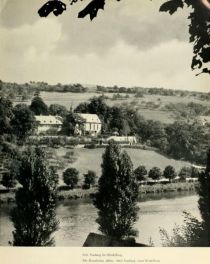
009 Stift Neuburg bei Heidelberg
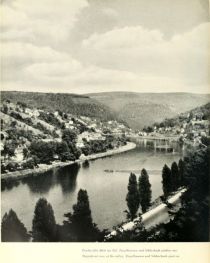
010 Prachtvoller Blick ins Tal. Ziegelhausen und Schlierbach grüßen uns
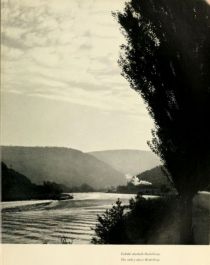
011 Talbild oberhalb Heidelbergs
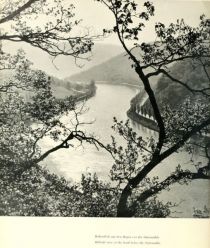
012 Höhenblick auf den Bogen vor der Stiftsmühle
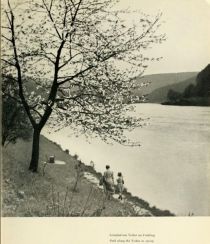
013 Leinpfad am Neckar im Frühling
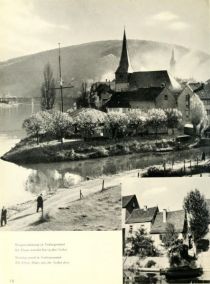
014 Morgenstimmung in Neckargemünd. Die Elsenz mündet hier in den Neckar
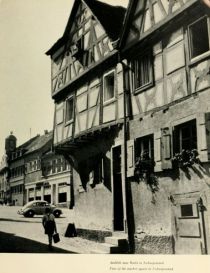
015 Ausblick zum Markt in Neckargemünd
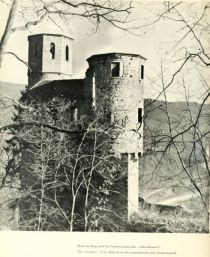
016 Hoch am Berg steht bei Neckarsteinach das Schwalbennest
alle Kapitel sehen